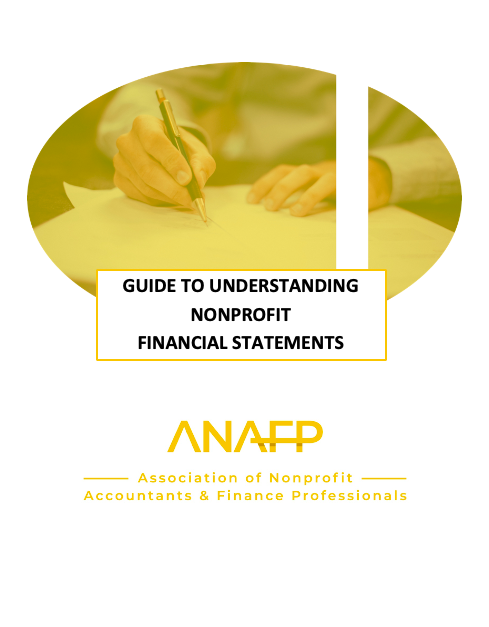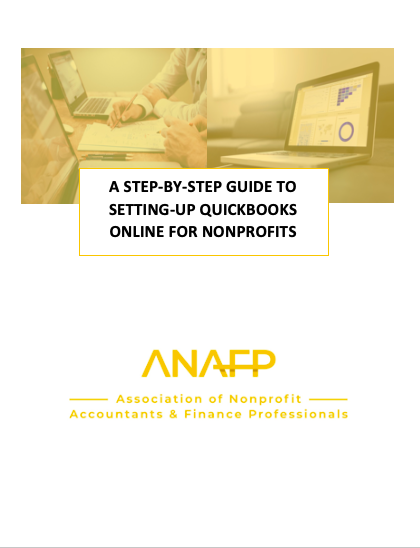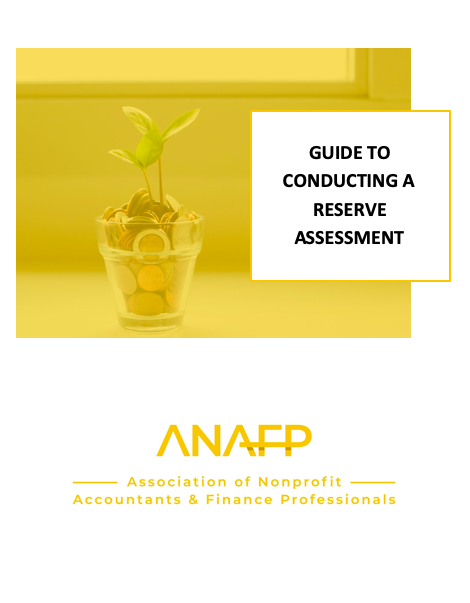- Home
- Professional Resources
- Accounting & Bookkeeping
Accounting & Bookkeeping Resources
Every nonprofit deserves well-educated accounting and finance staff.
Sign-up for ANAFP Publications and Emails.
|
Overview of Fund Accounting for Non-Profits
The concept of fund accounting is one of the main differences between for-profit and non-profit accounting. Its name comes from the fact that revenues and expenses are segregated in the accounting system into “funds” for the purpose of tracking each fund separately – primarily for reporting purposes. Learn more about fund accounting and how to apply these concepts. |
| Guide to Understanding Nonprofit Financial Statements Everyone working in nonprofit accounting and finance, including Board members, should have a strong grasp of reading and understanding nonprofit financial statements. ANAFP's Guide to Understanding Nonprofit Financial Statements will walk you through each financial statement so that you will understand how to interpret the information presented. |
| Understanding the Difference Between Restricted and Unrestricted Revenue One important aspect of nonprofit accounting is the classification of revenue as either restricted or unrestricted. Understanding the difference between these two types of revenue is critical for effective budgeting, financial reporting, and compliance. |
| Cost Allocations and the Statement of Functional Expenses (member only) The Statement of Functional Expenses is a key financial report for nonprofit organizations. To complete this statement accurately, nonprofits must understand which costs can be allocated and how to distribute them properly across functions. |
| Conditional versus Unconditional Revenue in Nonprofit Accounting (member only) Recognizing revenue accurately is essential to ensuring financial transparency and compliance with accounting standards. Discover how to properly recognize the difference between unconditional and conditional revenue in nonprofit accounting. |
| Understanding a Nonprofits Statement of Cash Flows (member only) Learn about the key components of a nonprofit's statement of cash flows and how to properly interpret this important statement. Understanding the statement of cash flows is essential for assessing the financial health and sustainability of any nonprofit organization. |
| Managing Cash Flow at a Nonprofit (member only) Cash flow management is critical for the success and sustainability of any nonprofit. Explore strategies to effectively manage a nonprofit's cash flow -- ensuring the organization can meet its obligations, invest in its mission, and achieve long-term financial sustainability. |
|
How to Account for Donations Pledged (member only)
Pledges are promises made by donors to provide a nonprofit with a donation at a future time-period. As with any donation received by a nonprofit, whether the donation is made currently or whether it is known to be forthcoming at a time-period in the future, the way in which the nonprofit records the transaction in the accounting system must adhere to generally accepted accounting principles for nonprofits. |
How to Account for Donations Received (member only) Most nonprofits exist due to the good nature of donations made by the public. Therefore, it’s important for all nonprofits to accurately account for these funds. Failure to do this could mean the nonprofit violated general accepted accounting principles for nonprofits. Learn more about what is considered a conditional and unconditional donation and purpose-restricted and time-restricted donations. |
| Key Differences Between a Public Charity and Public Foundation Nonprofits in the United States organized under U.S. IRS Code Section 501(c)3 may be classified as either a public charity or a private foundation. Learn the key differences between these two entities to ensure your organization is classified correctly. |
| How to Account for Donated Goods & Services (member only) Many nonprofits receive donated goods and services in lieu of cash contributions. Although this practice helps the nonprofit secure items and services that it may not be able to afford on its own, there are also accounting implications that the nonprofit must consider. Learn more about how to account for such items as well as the implications for receiving high-value assets. |
| How to Acknowledge Donations and Pledges (member only) All donations received should be acknowledged by nonprofits, and this includes pledges (promises to give in the future). The reason for this is it not only thanks the donor for the funds, but the donor may be relying on such acknowledgment for personal tax deductions. This article will not only help you understand what is needed and required in your acknowledgments but it will also help you better understand the IRS "substantiation" and "disclosure" requirements. |
| How to Calculate the IRS Public Support Test Nonprofits in the United States who function as public charities must pass the IRS public support test in order to remain classified as a public charity. Failing the test will have serious consequences as it will cause the public charity to be reclassified as a public foundation. Learn how to calculate your nonprofit's public support in order to properly file your annual tax return. |
| How to Account for Membership Dues Member benefits specified in membership agreements embody goods and/or services that a nonprofit has promised to transfer to members. These promises are deemed “performance obligations”, and the transaction price for each good/service must be accounted for when recording membership dues. |
| How to Account for Uncertain Tax Positions (member only) Nonprofits are required to account for uncertain, material tax positions in the accounting system and include such information in their financial statements. Determining if a nonprofit has any such positions requires a careful inventory of all tax positions and then deciding if any of these are uncertain. This article will provide an overview for conducting this analysis and explore common areas of uncertain tax positions. |
| Key Differences Between Capital & Operating Leases Many nonprofits opt to lease assets instead of purchasing them outright. Learn how to differentiate between capital and operating leases, how to determine which lease your asset falls under, and how to record the leases in the accounting system. |
| Common Internal Controls for Nonprofits Establishing sound internal controls is important for every nonprofit. These controls help ensure funds are not misappropriated and help keep fraud from occurring. However, establishing internal controls can sometimes prove difficult. Nevertheless, these are some of the common internal controls that should exist in nonprofits, regardless of size, because these controls are often reviewed by auditors as part of the annual financial audit. |
|
Differences Between Advertising Revenue and Sponsorships (member only)
Nonprofits looking for additional sources of income should pay close attention to the key differences between advertising revenue and sponsorships. Why? Because the Internal Revenue Service (IRS) has a very different definition for both of these terms and not knowing these differences can lead the nonprofit to pay unrelated business income tax. |
| Can Nonprofits Engage in Lobbying Activities (member only) Often times, nonprofits, in the course of their normal activities, find themselves engaging in public policy debate and, more importantly, lobbying efforts. In the United States, federal law allows nonprofits to lobby within certain limits. Knowing what constitutes lobbying under the law, and what the limits are, is key for every nonprofit to lobby both legally and safely. |
| What Constitutes Fundraising Costs Nonprofits are required to track and report expenses by three functional areas: program services, general and administrative, and fundraising. But what constitutes fundraising costs and how do these costs differ from development costs? Learn more about the definition of fundraising to help ensure your organization is accurately reporting, and not over-reporting, these expenses. |
| Guide to Setting-up QuickBooks Online for Nonprofits (member only) Be sure to properly set-up your nonprofit's QuickBooks Online account by downloading and reading ANAFP's Guide to Setting-up QuickBooks Online for Nonprofits. This guide will walk you through, step-by-step, the setting changes and edits you will need to make to QuickBooks Online so that you can accurately track revenues and expenses by donors, grants, projects, and service areas. |
|
Internal Control: What is the COSO Internal Control Framework
The Committee of Sponsoring Organizations of the Treadway Commission (“COSO”) established a model for evaluating internal controls for organizations. This model was adopted as the generally accepted framework for internal control, and it is widely recognized as the definitive standard against which organizations measure the effectiveness of their internal control systems. |
Downloadable ANAFP Guides



